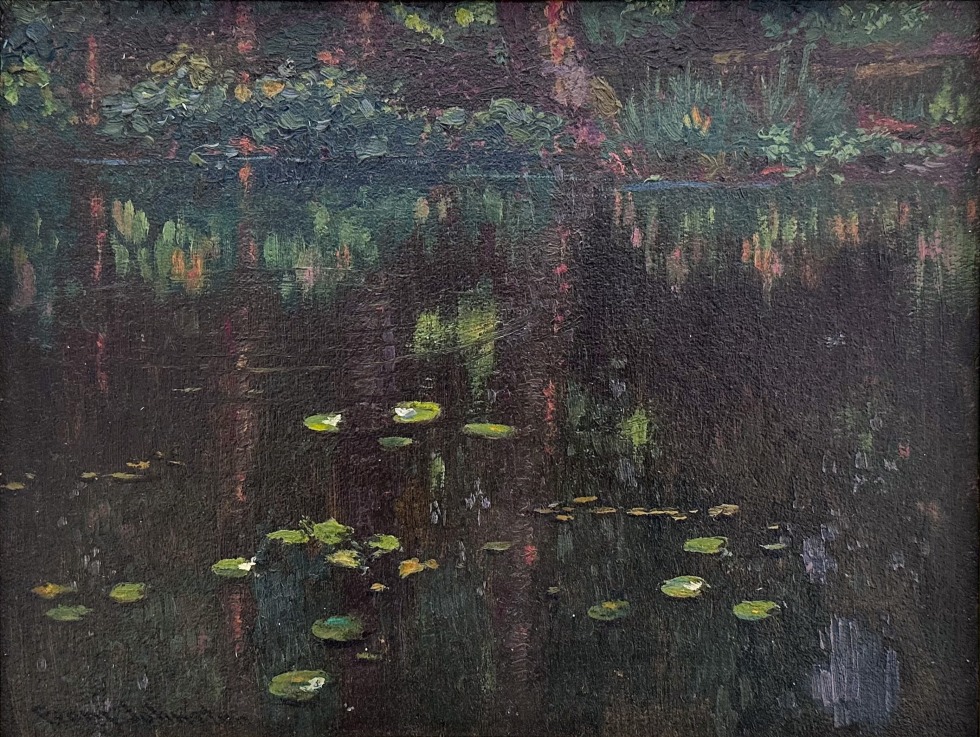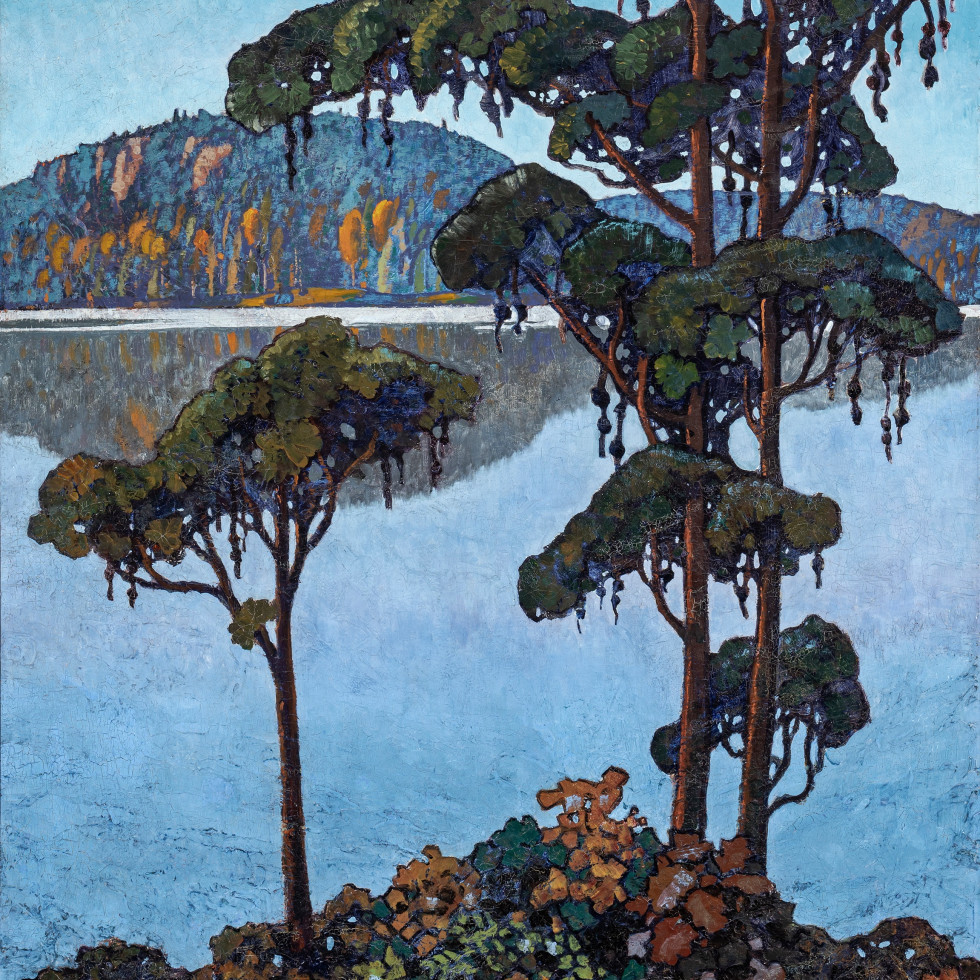Francis Hans (Frank/Franz) Johnston
 "It took us out into the open air to look at Canadian landscape as distinct from European landscape. It necessarily meant that each was free to look at the landscape which attracted him..."
Francis H. Johnson
"It took us out into the open air to look at Canadian landscape as distinct from European landscape. It necessarily meant that each was free to look at the landscape which attracted him..."
Francis H. Johnson
Frank H. Johnston was born in Toronto, Ontario to Hans Hamilton Johnston and Mary Elizabeth Roderick, both of Irish stock. He was educated at the Givins Street School, Central Technical School under Gustav Hahn and the Central Ontario School of Art under William Cruikshank and G.A. Reid. He served his apprenticeship with Brigden's Ltd. in Toronto and became employed by the Grip Engraving Company sometime in 1908.
Johnston went to the United States to continue his studies and attended the Pennsylvania Academy of Fine Art under Philip Hale and Daniel Garber. He moved to New York where he worked in the Carleton Illustrators Studios, a firm which was associated with the Carleton Studios in London. Johnston later returned to Toronto.
In 1918, Johnston was commissioned by the Canadian War Memorials to record the activities of Canadian flying personnel training for overseas duty. During this period he produced seventy-three (or more) works including watercolors, temperas and oils. Many of these paintings, although of a documentary nature, were brilliantly created through masterful composition and colouring (see A Check List of The War Collections of World War I, 1914-1918 and World War II, 1939-1945 by Major R.F. Wodehouse - The National Gallery of Canada, Ottawa, ON, 1968). Johnston's paintings are among the finest in the war collections. Following his service with the Canadian War Memorials he returned to Toronto where he probably spent some time at the Studio Building. In 1918, he accompanied Lawren Harris, J.E.H. MacDonald and Dr. James MacCallum in their first box-car trip to Algoma. This region of northern Ontario was an area of beauty in autumn. The trees of gold, yellow and crimson covering the majestic mountains and edges of the lakes and rivers moved the artists to create some of their finest canvases. Johnston returned to Algoma in 1919 with Jackson, MacDonald, Harris and Dr. MacCallum, who probably joined them later. This group went again in 1920. Johnston made scores of drawings and paintings of Algoma but few of them were reproduced in Canadian art history books with the exception of his Fire Swept, Algoma (National Gallery of Canada), God's Country (Mr. and Mrs. J. Loeb), In Algoma and Northern Cabin. In 1920, Johnston became a founding member of the Group of Seven - the others being J.E.H. MacDonald, A.Y. Jackson, Frank Carmichael, F.H. Varley, Arthur Lismer and Lawren Harris. Johnston exhibited in their first exhibitions, but in 1924 his association with the Group of Seven ended. They had become a target of attacks by critics and somehow their group spirit seemed to limit Johnston from doing what he wanted to do. He was every bit as eager to express his love of the Canadian wild as they were but he wanted to paint in a less controversial style. Johnston held a solo exhibit of his work at the T. Eaton Company in December, 1920, when The Mail & Empire noted, "the position of Frank H. Johnston, A.R.C.A., among local artists is unique. Mr. Johnston is always classed as one of the much discussed 'Group of Seven,' but he has never got out of touch with the picture lovers who cannot quite get the viewpoint of his ultra-radical companions .... He has the secret of the living, vivid coloring of the Northland, and catches the feeling of the wild spaces."
Johnston left Toronto after being appointed principal of the Winnipeg School of Art. He kept up his activities as a painter and held an exhibit of 326 of his paintings at the Winnipeg Art Gallery, of which Arthur Stoughton of the Winnipeg Free Press noted, "the greater number of the pictures are done in tempera, although this show presents evidence of the versatility of this man. He seems to have tried every color medium with good results. Here in No. 304, is a massive oil painting with all the solidity, which that material may present. Here in No. 60 and No. 280, are the wettest of transparent watercolors, composed of washes of most elusive tints, devoid of outline. Then there are watercolors, as in No. 281, done in that method of broken colour, dear to the heart of the impressionist or pointillist, in which spots of pure colour put side by side blend in the eye of the observer. Again there are some dozen pastels, which have a three-fold interest - first, from their good quality, second, because they present the artist's first impressions of Winnipeg, and third, as being his first essays in this medium." In December of that year Johnston held another exhibition of his paintings, particularly of Western Canada, which were described as having "the stimulus of the great spacious plains, magnificent cloud effects, glowing sunsets and enveloping sunshine."
Johnston was principal of the Winnipeg School of Art from 1920 to 1924, and eventually moved back to Toronto where he became principal of the Ontario College of Art. About 1926, Johnston changed his name from Frank to Franz because he was told by a numerologist friend in New York that the name Frank would never bring him success. Johnston wrote down the name Franz (name of a community east of White River, Ontario) and his friend told him it was an excellent choice. His canvases from then on were signed Franz Johnston.
Johnston was principal of the Ontario College of Art from 1927 to 1929. He exhibited his work throughout his career with the Ontario Society of Artists and the Royal Canadian Academy, as he was a member of both societies (O.S.A. and A.R.C.A.). In 1931, Simpson's Fine Arts Gallery created a new Franz Johnston Room for the express purpose of selling his paintings. Johnston established a summer school of art in Georgian Bay (1930-40) where he would be closer to the part of Ontario he loved to paint in the most. In 1940, he closed his summer school and settled at Wyebridge in the same region.
Johnston began to take trips into the far north in the 1930s and his work of this period was exhibited at several galleries, including the Maloney Gallery in Toronto. In 1938, Augustus Bridle in the Toronto Star noted Johnston's exhibit at Maloney's as follows:
"Canada's farthest-north regular painter has for three years brought the land of crackling sub-zero, shivering spruces and truculent huskie dogs into picture shows here ... What he has already painted of actual life in the Nipigon Country, as shown in this super-brilliant, intimate picture-saga at Maloney's, is to him a mere prelude to what he intends to paint of Canada's so-called 'lost frontier.'"
In 1939, Johnston was commissioned by Gilbert Labine, Vice-President of Eldorado Gold Mines, to go to the Canadian Arctic to paint nature, trappers, miners and First Nations people in all seasons. After five months he had completed 100 sketches. Working in temperatures of 35 to 40 below zero, he mixed his pigments, which had become like jelly, with pure turpentine. When he painted he covered his hand in a lumberman's sock through which he manipulated his brush. Many of these works were exhibited at Maloney's in December of that year.
In 1940, he completed a large canvas entitled Shack in the Woods, which he considered his masterpiece. He took it to a Toronto art dealer to sell and was in the process of negotiating for the best price when a man from New York entered the gallery and asked Johnston how much he wanted for the painting. Johnston stated $850.00 and the man purchased the work on the spot. Later, reproductions of this painting were sold by the thousands with Johnston receiving no royalties from their sales. In 1942, he exhibited some of his paintings from the Weybridge area and also some arctic paintings at Eaton's. He again exhibited at Eaton's in 1943. Augustus Bridle observed of paintings in the exhibit, "green-blue skies and lavender snows; blue snow-wraiths in the shadow against a blaze of early morn golden light; ravishing snakes of water as opalescent as rainbow-backed beetles; tousles of brushwood that look like jackpine or tamarac because painted so vividly [...] These are a few of the Wye-fantasias." Of the eighty paintings he exhibited, fifty percent were sold within three weeks. They ranged in price from $50 to one $1000 each.
In 1948, Johnston moved from Wyebridge to Midland, Ontario, but not long afterwards suffered a stroke. His paintings were in popular demand until his death. In July the Owen Sound Sun-Times noted his passing as follows,
"It may be said that, in a sense, Franz Johnston dedicated his professional life to Canada, for he had a deep appreciation for what this country had to offer. This sense of dedication was exemplified in his works. He painted Canadian things because he knew them best and he knew them best because he chose to live and work among the scenes and the people he portrayed.... He will be long remembered for his long-established summer art school on Georgian Bay. Here he not only created some of his own most famous paintings, but also guided the steps of many other painters along the pathway to success."
The bulk of Johnston's paintings still in his possession at the time of his death were purchased by Laing Galleries, Toronto. A plaque was unveiled by Mrs. John Schofield (formerly Mrs. Franz Johnston) on the grounds of his former residence at Wyebridge, Ontario on September 18, 1963. The Roberts Gallery, Toronto, held an exhibition of his work during the same year.
Johnston illustrated and did decorations for a number of books. He is represented in the following public collections: Saskatoon Art Centre; Winnipeg Art Gallery; London Public Art Museum, London, Ontario; Art Gallery of Ontario, Toronto; McMichael Conservation Collection, Kleinburg, Ontario; National Gallery of Canada (General Collection, and War Collection as mentioned above) and probably other public collections. His work can also be found in the following private collections: J.G. McCurdy, Regina, Saskatchewan; Arthur Cutten Jr.; Mr. and Mrs. Jules Loeb, Hull, Quebec; formerly in the collection of the late Dr. Tait Mackenzie; Franz Lawren Johnston (his son), Grimsby, Ontario; others of his surviving relatives and William G. Street, Richmond Hill, Ontario. At the time of his death Johnston was survived by his wife, four children: Frances-Anne Johnston, A.R.C.A. (wife of Franklin Arbuckle, R.C.A.) Toronto; Mrs. James Stevenson, Toronto; Paul Roderick (an artist who paints under this pseudonym); Franz Lawren Johnston and a brother, Harry Johnston, Toronto. A retrospective exhibition of his work was organized by his son Paul at the Rothman Art Gallery in Stratford, Ontario and opened in September, 1970.
A Dictionary of Canadian Artists, Volume 3
Colin S. MacDonald, First Edition 1971









